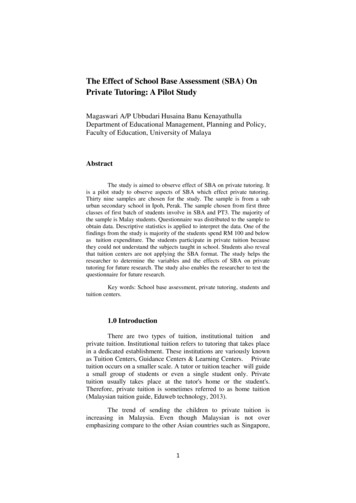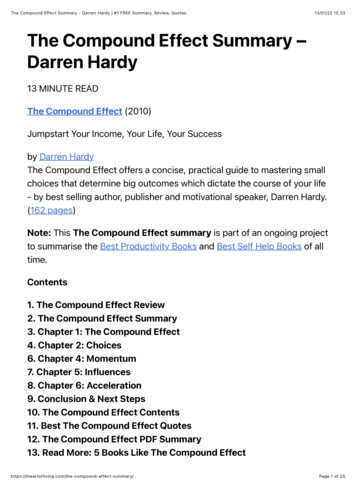
Transcription
The Effect of School Base Assessment (SBA) OnPrivate Tutoring: A Pilot StudyMagaswari A/P Ubbudari Husaina Banu KenayathullaDepartment of Educational Management, Planning and Policy,Faculty of Education, University of MalayaAbstractThe study is aimed to observe effect of SBA on private tutoring. Itis a pilot study to observe aspects of SBA which effect private tutoring.Thirty nine samples are chosen for the study. The sample is from a suburban secondary school in Ipoh, Perak. The sample chosen from first threeclasses of first batch of students involve in SBA and PT3. The majority ofthe sample is Malay students. Questionnaire was distributed to the sample toobtain data. Descriptive statistics is applied to interpret the data. One of thefindings from the study is majority of the students spend RM 100 and belowas tuition expenditure. The students participate in private tuition becausethey could not understand the subjects taught in school. Students also revealthat tuition centers are not applying the SBA format. The study helps theresearcher to determine the variables and the effects of SBA on privatetutoring for future research. The study also enables the researcher to test thequestionnaire for future research.Key words: School base assessment, private tutoring, students andtuition centers.1.0 IntroductionThere are two types of tuition, institutional tuition andprivate tuition. Institutional tuition refers to tutoring that takes placein a dedicated establishment. These institutions are variously knownas Tuition Centers, Guidance Centers & Learning Centers. Privatetuition occurs on a smaller scale. A tutor or tuition teacher will guidea small group of students or even a single student only. Privatetuition usually takes place at the tutor's home or the student's.Therefore, private tuition is sometimes referred to as home tuition(Malaysian tuition guide, Eduweb technology, 2013).The trend of sending the children to private tuition isincreasing in Malaysia. Even though Malaysian is not overemphasizing compare to the other Asian countries such as Singapore,1
China, Korea and Japan, but the numbers are increasing by year. Inthe Republic of Korea, nearly 90% of elementary students receivesome sort of shadow education. In Hong Kong, China, about 85% ofsenior secondary students do so. 60% of primary students in WestBengal, India, and 60% of secondary students in Kazakhstan receiveprivate tutoring ( Asian Development Bank, Fast Facts on “Shadoweducation ,2012 ) .Parents are spending a big portion of theirhousehold disposable income on private tutoring. According to Bray,2012, the trend is increasing in Asian countries. Examples in Japan,the number doubled from 12.0 percent in 1976 to 23.6 in 1993 (JapanMinistry of Education, Science, and Culture, 1995) In Singapore thepercentage increases from 26.0 to 49.0 percent within 1982 to 1992(George, 1992, cited by, Bray, M. 2012). There are a few factorswhich could contribute to the increasing trend in Asians. Shifttowards a new market in China and Vietnam government permittedand encourage the private tutoring services (Bray, M. 2012) are someof the factors contributed to the growth of private tutoring in Asians.The frequency of private tutoring may vary be- cause ofother factors, as well. As one might expect, children in higher socioeconomic groups generally receive more supplementary tutoring thando children in lower socio- economic groups (de Silva, 1994a;Foondun, 1998; Stevenson & Baker, 1992).Chew and Leong (1995) reported that 69.5 percent ofMalaysian students they sampled who received tutoring did sothroughout the year, while the others only received tutoring prior toimportant examinations.The important of private tutoring in Malaysia also increasedas the children enter secondary schooling and become even greaterif the children sit for any major examination. The private tutoringbecomes a lucrative business in Malaysia, especially in cities.According to Kenayathullah ,H.B., (2012), approximately 93% offamilies which allocate their income to private tutoring spend up to atenth of their total monthly expenditure. It shows that a big portion ofMalaysia families’ expenditures are spending on private tutoring.Even though there is no census is taken to shows the number ofstudents attending private tutoring in Malaysia, but approximationcould be obtain from studies done by researchers. For example, theMasterCard Worldwide Survey of Consumer Purchasing Priorities(2009) reported that 46% of Malaysian consumers rank the provisionof PT and extra-curricular activities for their children as one of thetop three spending priorities. In addition, statistics from the MerdekaCenter for Opinion Research (2005) found that 64% of Malaysianparents with school-going children send their children for PT classes,with English, Science and Mathematics as the three most popularsupplementary subjects ( cited by Jelani, J., & Tan, A. K.G, 2012).2
Jelani, J. and Tan, A. studies also cited that 83.3% of Malaysianstudents received private tutoring by the time they reached lowersecondary.(Marimuthu at,1991)The primary factor which determinant the needs for privatetutoring is the aspiration to perform well in school examinations.Parents want their child to perform better than other children as theycan take pride in the success of their children. Parents compare thesuccess of the children and compel them to get good grades.Malaysian curriculum structure (KBSR and KBSM) which gives agreater emphasis on examination become a prime factor to create ademand for private tutoring.Students from high and middle income group could get thebenefit of private tutoring. This will increase the gap between thelow income group students with middle and high socio economicstatus students. The Malaysian government’s effort in NationalBlueprint (shift one; equality), to bridge the gap between differentethnic and socio economic group will be hampered. Bray.M,2012,cited de Silva, 1994a;Foondun,1998; Stevenson & Baker ,1992 , thatchildren in higher socio-economic group generally receive moresupplementary tutoring than children from lower socio-economicgroups.Cultural, economic and educational are most importantfactors in affecting the scale and nature of private tutoring (Bray, M.,2012). The primary factor which determinant the needs for privatetutoring is the culture in some Asian countries. . Asian culture thatemphasis the important of excellence in academic creates demand forprivate tutoring. . According to Rohlen & LeTendre, 1996; Salili,1999 cited by Bray. ,2012, nation which is influence by theConfusious traditions, likely emphasis on private tutoring. Parentswant their child to perform better than other children as they can takepride in the success of their children. Intake of higher education baseon meritocracy increases the need of excellent result. A study byJelani and Tan, 2012, found that a higher percentage of ethnic Indian(71%) and Chinese (63%) students receive private tutoring, whileethnic Malay (39%) students are less likely to undertake privatetutoring in Malaysia.Rate of return to human capital also affect the demand forprivate tutoring. Studies have found that economic returns increasesas the people attain higher education (Kwan-Terry 1991 andPsacharopoulos ,1994, cited by Bray,M.,2012 .)It is prevalent in3
Asian countries compare to theunited kingdom).western countries ( America andThe nature of Malaysian curriculum structure ( KBSR andKBSM) which gives a greater emphasis on examination also becomea prime factor to create a demand for private tutoring. This issupported by Bray, M., 2012, “ Education systems in which successon examinations can be promoted easily through preparation, thosethat are teacher-centered rather than child- centered, and those thatare intolerant of slower learners all tend to promote use ofsupplementary tutoring.”In many Asian countries the percentage of students enrollingin private tutoring is higher in urban than rural. In a study by Bray(1999b), found that 60.6 percent Cambodian urban schools studentsreceive private tutoring than only 9.1 percent from rural schoolstudents. Chew and Leong, 1995(cited by Bray, 2012), observed that59 percent in Malaysian urban schools received tutoring than ruralschool students with 28.5 percent only. The study also reveal that thehigh competitiveness among urban school students, parents highereducational attainment and higher socio-economic status are amongthe reasons for the prevalent differences among the urban and ruralschool students receiving private tutoring. A study by Jelani andTan, 2012, cited earlier findings by Marimuthu et al. (1991) morethan two decades ago noted that socio-demographic characteristicsplay an important role in the growing phenomenon of PTparticipation amongst school-going children in Malaysia. Based onthe report, 83.3% of Malaysian pupils will have received privatetutoring by the time they reached lower secondary school. At thesame time, a notably higher proportion of urban school children(59.0%) enrolled in private tutoring compared to those in the ruralareas (28.5%). Fergany (1994) and Tseng (1998) found similarsituations in Egypt and Taiwan, respectively.Rich parents could afford to send their children to singlestudent-teacher tuition services or home tuition. The home tuitionservice is more expensive than group tutoring. The advantage ofhome tutoring is the student get the attention of the teacher byhimself. Parents from low-income or middle class could not afford tothe home tuition services. They send their children to a group tuitionwhich may not be as effective as the latter. Children from cities havebetter access to tuition compare to the children from rural. Thus, theurban children may perform well compare to rural children. This willbe an obstacle in government policy (National Education Blueprint,shift one and New Malaysian Economic Plan 2010) for equity andequality among the different race in Malaysia and rural and urbanstudents. Countries like South Korea and Mauritius government tryto ban private tutoring because it creates inequality4
(Kenayathullah,H.B.,2012). Malaysian government as a publicpolicy maker should give prior attention to regulate and controlprivate tutoring. A detail and comprehensive policy is needed toreduce the dependent on private tutoring. New policy is also neededto control the mushrooming of private tuition classes which are beingheld at individual houses. Even it is against the law, but t is anincreasing trend in Malaysia. This type of private tuition is mostlyconducted by school teachers. It is a convenient method as theteachers are not answerable to the ministry or to their principle as it isvery difficult to acknowledge its establishment. The income also nottaxable as it is not registered and declared. The residential privatetutoring are very difficult to monitor as it is held at individual housesand government department does not have access.2.0 The public policy on private tutoringThe education act 1996 (act 550), it is mainly focus oninstitutional private tuition. The department of private education alsoissues regulations to private tutoring institutions. The department hasissued detailed and comprehensive regulations from establishing theinstitutions to quality control of the institutions.However until 1999, there is no policy or regulations fromthe department of private education which could regulate andmonitor private tutoring in Malaysia. Education ministry issued acircular on 1999(SPP 1/1999), guideline to education departmentemployees of the involvement in outside employment. Accordingto the circular, teachers must apply for approval from head ofdepartment to conduct activities which generate income other thancurrent employment. Government servant should get the writtenapproval from the head of department to conduct any businessoutside. In 2006 (SPP Bi.l 1/2006), education ministry issued aspecific circular on guideline to give approval to teachers to teachprivate tuition. This is because it become rampant that manyemployees are not complies with the earlier regulation. Thedepartment received many complain about teachers involvement intuition classes without the approval from the head of department. Thedepartment also received complains that teachers give priorities totuition than their teaching and learning at school. The circularindicate that the teachers are not allowed to conduct private tutoringnot more than four hours per week.Teachers also prohibited from promoting their tuitionservices among school students and involve in private tutoringinstitutions operated by close relatives. Teachers also need to applyyearly for approval to conduct private tutoring from the head ofdepartments. The private tutoring teachers also should ensure theyattain at least eighty percent performance score. Teachers alsorequired to attain their job confirmation before involve in private5
tuition. Approval is given to the teachers to give tuition only atcenters registered with the state department. Teachers are prohibitedto give home tuition. Teachers also prohibited from using anyresources from the school for the tuition purposes. Teachers are notallowed to provide their tuition services not more than twenty fivekm from their working place. Teachers are given approval toconduct tuition only for one year. However they could extend theirservices using the previous application.Application requirement:The document required to submit the application is asbelow:1.Two application copies( Appendix A)2.A photocopy of service book3.A photocopy of school time table4.A photocopy of license of tuition centerregistered with state educationdepartment5.A photocopy of offer letter as tuition teacherfrom tuition centre.6.A photocopy of tuition class time tableThe head of department must ensure that the applicantcomplies with all the regulation before the approval is given. It is theresponsibility of the head of the department to monitor the applicant.The head of department also should monitor that the applicantcompile with the terms of Rule 5 (3) of the Rules of Public Officers(Conduct and Discipline) Regulation 1993. The rules are as below:1.The job is not performed during office hourswhile ensure that the officer is required to perform his officialduty with prudence6
2.Not in any way misused his position as public3.Not in any way conflict with the interest ofservantdepartment or inconsistent with his current position2.1 The implementation processApplication from officers with DG forty eight and abovemust be approved by Secretary General. Applications from officersbelow DG forty eight are approved by the head of department.However the school level application is approved by the Director ofstate education department. Application from teachers institutelectures, approval is given by the Director of teachers’ educationsection. Application from Matriculation lectures, approval is givenby the Director of Matriculation section. Director of technical andvocational section will approve application from technical andvocational school teachers. A copy of approval letter will beforwarded to the head of department.The policy on private tutoring is a top-down approach. Thepolicy is formulated by Education Ministry and imposes on theteachers. The head of department is instructed by the ministry tomonitor the teachers at school level. The principle is not givensufficient information on the policy. The circular was send to theschools and instructed to implement it. It is depend on the school tochoose the implementation process.The district or state education department does not monitorthe implementation of the circular at school level. Even at theministry level, there is not much emphasis on monitoring theimplementation process of the policy. It is depend on the principle toimplement and monitor the policy. When there is lack of monitoringfrom the stake holders, the policy fail to implement successfully (Haddad, W. ,2012). The success of a policy depends on certainfactors. According to the implementation theoretical framework, asuccess of a policy depends on the interaction between people, policyand place.PEOPLE7
POLICYPLACE(Dimensions of contemporary education policy implementation yImplementation,2006. )Key dimensions of policy are goal, target and tools. Thethree dimensions must align for the policy to be success.People or the actors involved should have sufficientinformation on the policy. The ministry must ensure that, theteachers, principals and parents are briefed on the policy.Overall, policy, people, and places must cometogether to form a conception of implementation as a highlycontingent (dependent) and situated process.It is very difficult for the head of department to takedisciplinary action against the teachers as he might not has sufficientevidence to support the action. Teachers are reluctant to apply for theapproval as the process is intricate and time consuming. Even thoughthe requirement for the approval is by the head of department, but inreality they need to get the approval from the department. They needto establish documents to support their applications. Even most of theteachers conduct tuition at centers; they are a few who conducttuition at their home. As it is conducted at the teacher’s house,teachers could not acquire the approval. Hence, it is not possible forthe head of department to monitor the progress of these teachers.Tuition teachers are skeptical about the perception of the head ofdepartment on their performance at school. They are worried that thehead of department will give low marks for their annual performanceappraisals.8
Ethically it is the responsibility of the teachers to inform thehead of department about their involvement in tuition services. Theteachers are bound by the Rules of public officers (conduct anddiscipline) to apply for the approval from the department.2.2 Monitoring ProcessThe head of department should monitor the job performanceof the teachers involved in tuition. They should ensure that theteachers abide the rules and regulations as stated in the circular. Thehead of department could take disciplinary action against the teacherif it is known that they fail to get the approval or violate the rules andregulations in conducting tuition services. The head of departmentrequired to submit a report on the progress of teachers involved intuition. The report should be submitted every six months once. Thereport is submitted to the Secretary, ministry of education withattention to director of section.However the rules are not impose on teachers involve withtuition voucher skim. The teachers from this skim are not allowed toconduct tuition at tuition centers. The head of department mustensure the rules are compiling by the teachers.Currently the private education unit of education ministry isresponsible for monitoring private tuition in Malaysia. However, theunit is mainly emphasis on private education than private tuition.The unit focus on monitoringand accreditation the privateinstitutions programs.3.0 School Base Assessment System3.1 IntroductionIn 2012, the Malaysian curriculum was revamped and a newpolicy was introduced. It is KSSR for primary school and KSSM forsecondary schools. The new policy was intended to eventuallydecrease the examination oriented syllabus to a holistic approach.School based assessment ( or refer as PBS- “Pentaksiran berasaskansekolah” in malay) was introduces to replace the UPSR and PMRwhich is a summative format examination. In UPSR and PMRexamination, students performance are measured with the number of“A” students obtained. Examination oriented approach decreasestudents ability in critical and creativities thinking. This could be isone of the reasons why Malaysia students performed below the par inPISA and TIMMS. KSSR and KSSM is a holistic approach whichevaluate the students ability in a school base assessment from aperiod of 3 years and it is formative. Students are evaluatedindividually and each student is given a “Band” on their performance9
evaluation range from one to six. The highest band is six and it isawarded to excellent students who are articulate in every aspect(creative, critical, intellectual and good values).Malaysian current examination system is a adaptation ofBritish public examination system, such as LCE/ PMR, MCE/ SPMand HSC/ STPM (Lowercertificate of examination, MalaysianCertificate of examination and higher school certificate). The systemis too examination oriented. Not much was focus on other aspects oflearning process. The current examination system tests the student’smemory power rather than thinking and problem solving skills. It isvery much centralized. Examination question is developed by theMalaysian Examination syndicate ( Lembaga Peperiksaan Malaysia )and Malaysian Examination Council ( Majlis Peperiksaan Malaysia).External examiners (teachers from different school) are appointed tosupervise the examination process. Answer templates are marked byappointed teachers, whodo not have any knowledge on thecandidates. The whole process place too much pressure on thestudents. The teachers, parents and school principles also anticipatethe pressure. Students and schools results were compared andpublished in newspapers.Toffler is often quoted for his claim that the greatestchallenge in the 21st century is not learning, but to unlearn andrelearn ( cited by Majid ,F.A., 2011, School-based Assessment inMalaysian Schools: The Concerns of the English Teachers ,) .Globalization and information technology cause the education systemto change. “. Change management‟ has long a place in the context ofcontinuous improvement ( Faizah ,M.A ,2011). To anticipate with thechanges, transformation was implemented in Malaysian examinationsystem. One of the major changes is the implementation of SchoolBase Assessment system. It was introduced in 2010 to primaryschool ( KSSR). Eventually, it was extended to from one students in2012( KSSM) . The system is aimed to remain the examinationsystem but to a lower stake on primary and secondary level (SchoolBased Assessment as Transformation In Educational Assessment, the4th international conference on measurement and evaluation ineducation. University Science Malaysia, Pulau Pinang,2011).3.2 Policy Implementation Process3.2.1 Opinions gathered from stakeholders10
National Educational Assessment System (NEAS) shouldconcentrate on school- based assessment and examinations shouldremain in the system but at a lower stake at primary and secondaryeducation .3.2.2 Input from experts in educational assessmentThe call for reformation in educational assessment system inMalaysia was that a reliable and appropriate school-based assessmentsystem be introduced .Put less emphasis on evaluating learners basedon their ability to pass an examination3.3 Rationale For School-based Assessment/ PentaksiranBerasaskan Sekolah (PBS):To achieves the aspiration of National Philosophy ofEducation towards developing learners’ physical, emotional,spiritual and intellectual abilities. To reduce exam-oriented learning among learners To evaluate learners’ learning progress To enhance teachers’ integrity in assessing, recordingand reporting of learners’ learning.3.4 SBA Features Assessment for and of learning Standard-referenced Assessment Holistic Integrated Balance Robust11
3.5 Components of PBS Academic: School Assessment(using Performance Standards) Centralised AssessmentNon-academic: t (Pentaksiran Aktiviti Jasmani, SukandanKokurikulum - PAJSK) Psychometric/Psychological Tests3.6 Centralized AssessmentIt is conducted and administered by teachers in schools usinginstruments, rubrics, guidelines, time line and procedures prepared byLP.Monitoring and moderation conducted by PBS Committeeat School, District and State Education Department, and LP heMasterCard Worldwide Survey of Consumer Purchasing Priorities(2009) reported that 46% of Malaysian consumers rank the provisionof private tutoring and extra-curricular activities for their children asone of the top three spending priorities. In addition, statistics fromthe Merdeka Center for Opinion Research (2005) found that 64% ofMalaysian parents with school-going children send their children forprivate tutoring classes, with English, Science and Mathematics asthe three most popular supplementary subjects.3.6.1 School AssessmentThe emphasis is on collecting first hand information aboutpupils’ learning based on curriculum standards.Teachers plan the assessment, prepare the instrumentand administer the assessment during teaching and learningprocess.Teachers mark pupils’ responses and report theirprogress.12
t – (PAJSK)*Teachers record learners’ physical endurance and bodymass index, and learners’ participation, involvement andcontributions in sports, co- curriculum and extracurricular activities.* Acknowledgement and recognition of pupils’ participationin sports and outdoor activities as part of learning process.Psychometric Assessment A profiling assessment which emphasizes on pupils’learning inclination, attitudes, interest and personality. Enables teachers to help learners in their learning inaccordance to their profile and identify the areas of theirinterest according to their innate ability.3.7 Quality Assurance Mentoring monitoring, moderating, anddetectingmeasures to ensure the validity and reliability of the assessments.3.8 PBS Management System (SPPBS) PBS Management System (Sistem Pengurusan PBS –SPPBS) – for Academic The Application for Physical Activities, Sports andCo-Curriculum Assessment (PAJSK) – for Non academic. Help teachers’ record information about learners’acquisition of knowledge and skills in PBS. Reports could be generated instantly wheneverneeded.13
(Source : Examinations Director (MES),KPM,2013.)B. Pilot Study3.0 Methodology3.1 SampleA pilot study will be carried out. The sample is thirty formthree students in a secondary school in the district of Kinta. It is apurposive sample. The respondents are the first batch of students whowill be evaluated by the new policy. The sample for the pilot study isthirty first class students. Questionnaire is distributed to all thestudents in the class regardless they are receiving private tuition ornot. Since it is a pilot study, the sample does not represent an actualrepresentative on Malaysian population in term of race and gender.Majority of the sample is Malay students. It is a suburban school,around twenty minutes drive to Ipoh town (which has more than 75%tuition centers. ) The school is situated in residential area. There is apublic bus service available from the residential area to Ipoh. There isonly one registered tuition center in the residential area.3.2 Research Design3.2.1 Data Collection Method3.2.1.1 SurveyQuestionnaires will be distributed to thirty students.Researcher will distribute the questioner to form three students fromfirst class. The students are placed into first class according to theirlast year end of the term results.The questionnaire has twosections. The first section is demographic data. Second section is thequestions on private tutoring and the affect of SBA. The researcherwill explain the questions to the students. This is to ensure accurateinformation is obtained. There are a few questions which studentsneed to choose the best answers. It is very important to explain to thestudents to avoid multiple chosen answers. At the end of the session,the questionnaire will be collected.3.2.1.2 Interview. Two school teachers who are providing tuition are selectedfor interview. The teachers are selected for interview to obtaininformation regarding their knowledge on the existence of the policy14
and the implementation. The number is sufficient as it is qualitativedata ( Cresswell,2012) . The interview protocol is attached at theappendix.3.3.1Validity and ReliabilityIt is a pilot study, thus the generalization could not be obtainusing the findings. However, the researcher will ensure the validityand reliability of the data from the study. Researcher will explain thequestionnaire to ensure the students could give accurate data.Students are not selected from the first class, questionnaire isdistributed to all the students regardless they are receiving tuition ornot. This will increase the reliability of the data. Teachers are alsochosen randomly as to ensure the validity of the interview data. Theresearcher needs to analyze the data carefully because the samplesare academically incline students (base on their results). The level ofmotivation and understanding of the curriculum are different fromother students.4.0 Data Analysis4.1 Descriptive analysis will be used to analysis the datafrom the questionnaires. Interview data will be analyze in qualitativemethod (quotations) .5.0 Significance of the studyThe study will help to understand the effect of school baseassessment on the demand of private tutoring. The finding is verycrucial for the researcher to determine the needs for future researchon the topic. The pilot study will enable the researcher to test thequestionnaire and ensure it’s authentic. It will provide a platform forthe researcher to gain experience in research.15
6.0 Findings6.1 Demographic of the studyClass 0Total315111008420181614121086420MaleFemaleTaking Nottuition takingtuition3S16
161412108MaleFemale6420TakingNottuition takingtution3M181614121086420MaleFemaleTaking Nottution Takingtuiton3K17
6.2 Descriptive AnalysisInitially the study only focused on first class students assample. However during the data collecting process, the researcherfound out that only 6 s
in private tutoring is higher in urban than rural. In a study by Bray (1999b), found that 60.6 percent Cambodian urban schools students receive private tutoring than only 9.1 percent from rural school students. Chew and Leong, 1995(cited by Bray, 2012), observed that 59 percent in Malaysian urban schools received tutoring than rural











